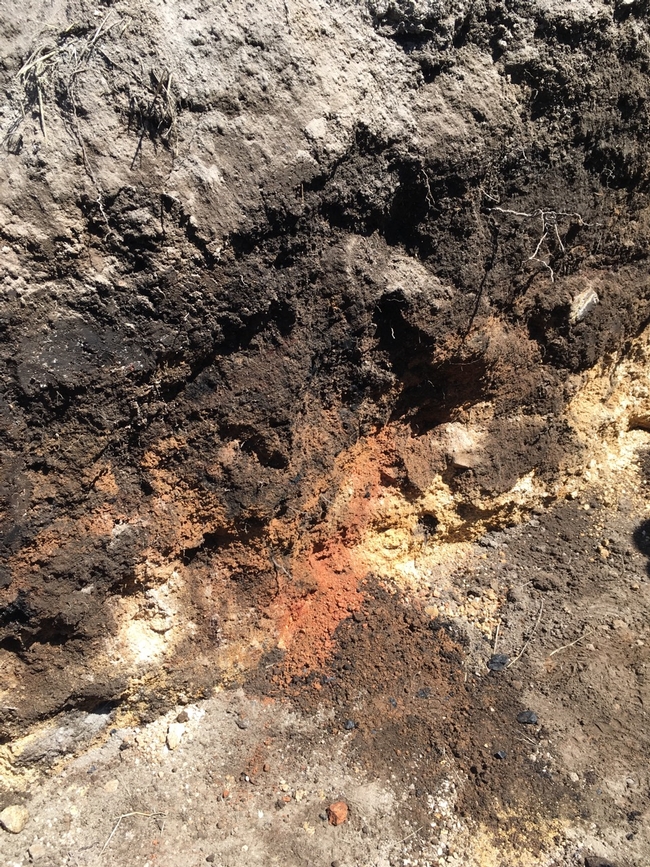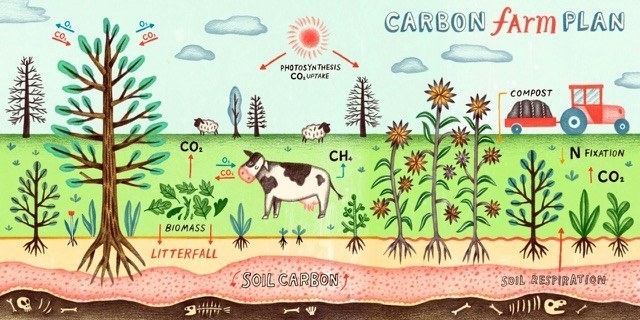
Posts Tagged: carbon
Soil Hoarding Carbon
Joint research conducted by The Nature Conservancy and the Kunming Institute of Botany, Chinese Academy of Sciences calculated the carbon-storing power of global soils and showcased approaches like agroforestry designed to capitalise on untapped potential.
A critical, nature-based approach to mitigating climate change has been right at our feet all along, according to a new study revealing that soil represents up 25% of the total global potential for natural climate solutions (NCS) – approaches that absorb CO2 from the atmosphere and lock it into landscapes, including forests, croplands and peatlands.
Representing the first time soil's total global potential for carbon-mitigation across forests, wetlands, agriculture and grasslands together has been catalogued, the study – led by scientists from The Nature Conservancy alongside Conservation International, Woods Hole Research Centre, University of Aberdeen, Yale University and the Kunming Institute of Botany, Chinese Academy of Sciences(KIB/CAS) – provided a timely reminder in this critical 'super year' for nature not to neglect the power of soils and the many benefits these ecosystems can deliver for climate, wildlife and agriculture.
Published in the journal Nature Sustainabilityentitled "The role of soil carbon in natural climate solutions". the research also argued that a lack of clarity to date regarding the full scale of this opportunity and how to best capitalise on it has restricted investment.
"While momentum continues to build behind the role nature can play in the global response to climate change, soils have historically enjoyed less of the limelight as a 'natural climate solution' compared with, say, forests or mangroves. Our study is designed to redress this situation," said lead author Dr. Deborah Bossio, The Nature Conservancy's Lead Soil Scientist. "By highlighting the full carbon-mitigation potential of soils across a range of landscapes, but also – crucially – exploring practical mechanisms that already exist for accelerating the uptake of these comparatively untapped approaches, including their integration into burgeoning carbon markets. This is particularly important for agriculture sector, for which more effective management of soils represents the single biggest contribution this industry can make towards mitigating climate change."
"Soils and improved soil management have a tremendous potential to store carbon. Agroforestry, and more generally just including more trees in the agricultural landscape, has been shown to be one of the most important approaches to increasing soil organic carbon with substantial global mitigation potential. In addition, highlighting the complimentary beneficial impacts available from improved agricultural production practices aimed at improving soil health, both the increased on-farm bio-diversity and livelihood diversification can enhance farm and ecosystem resilience," said co-author Dr. Robert Zomer of the KIB/CAS.
Demonstrating that soil carbon represents up to 25% of total global NCS potential, the paper also estimated that 40% of this potential will be delivered by protecting existing soil carbon reserves, while 60% will come from rebuilding stocks depleted by practices such as over-intensive arable agriculture and the draining of peatlands.
Breaking these data down further, the researchers also showed the share of total NCS potential that soil represents across various, climate-critical landscapes – from a relatively diminutive 9% of forest mitigation potential, through 47% for agricultural lands and grasslands, right up to 72% of total carbon sequestration potential in wetland landscapes.
The study also showed that agroforestry systems can have significant positive impacts on soil organic carbon across specific geographies. Moreover, the majority of other soil carbon pathways tend to be "no regrets" practices that deliver soil fertility, climate resilience and provide other ecosystem services alongside climate mitigation.
"We already know that nature has a powerful role in mitigating runaway climate change," said Prof. XU Jianchu from KIB/CAS, who was not associated with the study. “This study showed the NCS provide pathways for sustainable development that have both climate mitigation and livelihood improvement potential. It is essential that soil health become a central pillar of agricultural production, not just for climate mitigation, but also for both environmental and food security."

soil layers
Pore Variety Increases Soil Carbon Storage
The more different the root architecture, the greater potential to store more carbon
The greater the diversity of the rooting network, the greater diversity of pores
It's not just the biomass that stores the carbon, it's the diversity of the pores
So plant a greater diversity of plants to increase stored soil carbon
EAST LANSING, Mich. -- Alexandra Kravchenko, Michigan State University professor in the Department of Plant, Soil and Microbial Sciences, and several of her colleagues recently discovered a new mechanism determining how carbon is stored in soils that could improve the climate resilience of cropping systems and also reduce their carbon footprints.
The findings, published last week in the scientific journal Nature Communications, reveal the importance of soil pore structure for stimulating soil carbon accumulation and protection.
"Understanding how carbon is stored in soils is important for thinking about solutions for climate change," said Phil Robertson, University Distinguished Professor of Plant, Soil and Microbial Sciences, and a co-author of the study. "It's also pretty important for ways to think about soil fertility and therefore, crop production."
The study was conducted through the MSU Great Lakes Bioenergy Research Center, funded by the U.S. Department of Energy, and the Kellogg Biological Station Long-term Ecological Research program funded by the National Science Foundation, or NSF, and it was supported by NSF's Division of Earth Sciences.
Over a period of nine years, researchers studied five different cropping systems in a replicated field experiment in southwest Michigan. Of the five cropping systems, only the two with high plant diversity resulted in higher levels of soil carbon. Kravchenko and her colleagues used X-ray micro-tomography and micro-scale enzyme mapping to show how pore structures affect microbial activity and carbon protection in these systems, and how plant diversity then impacts the development of soil pores conducive to greater carbon storage.
John Schade, from the NSF Division of Environmental Biology, said the results may transform the understanding of how carbon and climate can interact in plant and soil microbial communities.
"This is a clear demonstration of a unique mechanism by which biological communities can alter the environment, with fundamental consequences for carbon cycling," Schade said.
"One thing that scientists always tend to assume is that the places where the new carbon enters the soil are also the places where it is processed by microbes and is subsequently stored and protected," Kravchenko said. "What we have found is that in order to be protected, the carbon has to move; it cannot be protected in the same place where it enters."
Scientists have traditionally believed soil aggregates, clusters of soil particles, were the principal locations for stable carbon storage.
Recent evidence, however, shows that most stable carbon appears to be the result of microbes producing organic compounds that are then adsorbed onto soil mineral particles. The research further reveals that soil pores created by root systems provide an ideal habitat where this can occur.
Of particular importance are soils from ecosystems with higher plant diversity. Soils from restored prairie ecosystems, with many different plant species, had many more pores of the right size for stable carbon storage than did a pure stand of switchgrass.
"What we found in native prairie, probably because of all the interactions between the roots of diverse species, is that the entire soil matrix is covered with a network of pores," Kravchenko said. "Thus, the distance between the locations where the carbon input occurs, and the mineral surfaces on which it can be protected is very short.
"So, a lot of carbon is being gained by the soil. In monoculture switchgrass the pore network was much weaker, so the microbial metabolites had a much longer way to travel to the protective mineral surfaces," explained Kravchenko.
Robertson said the research may prompt farmers to focus on plant diversity when attempting to increase soil carbon storage.
"We used to think the main way to put more carbon in soil is to have plants produce more biomass either as roots or as residue left on the soil surface to decompose," Robertson said.
"What this research points out is that there are smarter ways of storing carbon than such brute force approaches. If we can design or breed crops with rooting characteristics that favor this kind of soil porosity and therefore that favor soil carbon stabilization, that would be a pretty smart way to design systems that can build carbon faster."
Nick Haddad, director of the Kellogg Biological Station Long-term Ecological Research program, said research that builds from these findings will continue to discover ways to improve the sustainability of agricultural ecosystems and landscapes.
"Long-term research shows surprising ways that a diversity of plants can benefit the microbes needed for a resilient agricultural system," Haddad added.
Read the whole story:
https://www.nature.com/articles/s41467-019-11057-4

soil pores
Farming For Carbon
The Nuts and Bolts of Carbon Farming
I recently attended a Carbon Farm Plan Training hosting by Restoration Oaks Ranch, the Cachuma Resource Conservation District, and the Carbon Cycle Institute. I had heard about carbon farm plans and understood the concept, but attending this training gave me a much greater appreciation of what the nitty gritty details of creating one of these plans entails.
In a nutshell, a carbon farm plan takes a look at your farm from a carbon cycling perspective. The management practices that take place on the landscape influence the ins and outs of carbon moving through the system. Land management can push the meter towards increasing carbon into the system or releasing it out of the system. Developing a carbon farm plan creates a blueprint of management practices that lead to a net gain of carbon into the land system.
Agriculture is the one sector that has the ability to change from a net carbon emitter to a net carbon sequesterer. Common agricultural practices such as over-grazing, tilling the soil, over application of chemical fertilizers and pesticides, and mismanaged irrigation can result in carbon emissions, contributing to climate change. Removing carbon through harvesting crops without adequate replacement further depletes the carbon content of the soil. Carbon farming relies on plants doing the thing they do best, photosynthesizing, and maximizes the carbon cycle to result in a net gain of soil carbon. In this way, carbon farming improves the rate that carbon dioxide is removed from the atmosphere and converted to soil carbon or plant tissues, allowing agriculture to act as a net carbon sink. This process builds soil organic matter, which then increases water infiltration, enhances water-holding capacity, improves soil structure, and promotes soil microbiota diversity.
A Carbon Farm Plan is a long-term document created through a process modeled after the Natural Resource Conservation Service (NRCS) Conservation Plan. Local Resource Conservation Districts (RCDs) and agricultural support organizations (such as UC Cooperative Extension) provide the planning support to individual farmers and ranchers when creating a Carbon Farm Plan. The process begins with taking an overall inventory of natural resource conditions on the farm or ranch and generating a list of opportunities for enhanced carbon storage. The list of potential practices are refined based on the management goals of the farmer or rancher. Next, the carbon benefit potential for each practice is quantified using a set of online tools (COMET-Planner and COMET-Farm) developed by Colorado State University, NRCS, Carbon Cycle Institute, and the Marin Carbon Project. Once the list of practices are identified, prioritized, and quantified, a document is generated that lays out a plan of implementation based on funding sources and technical assistance.

What practices might you want to include in a Carbon Farm Plan? The NRCS has described many conservation practices that promote soil carbon sequestration and reduce greenhouse gas emissions. Some of these include:
- Cover cropping
- Compost application
- Reduced till or no till
- Multi-story cropping
- Windbreak and shelterbelt establishment
- Silvopasture establishment
- Forage and biomass planting
- Nutrient management
- Range planting
- Hedgerow planting
- Mulch application
A Carbon Farm Plan creates a road map for managing agricultural and working lands through a carbon lens. However, it also provides a working framework to address many ecosystem co-benefits that affect viability of agriculture in a changing climate. Improvements to soil health increase water holding capacity, soil stability and structural integrity, and decreases nutrient and water runoff. In addition, planting herbaceous and woody plants can sequester carbon while improving pollinator habitat. These practices influence the carbon cycle, but more broadly help agriculture build resiliency to drought, water inconsistencies, and temperature variability as the climate changes.
Let's get (carbon) farming!

Climate smart agriculture encompasses management practices that increase soil carbon sequestration, reduce greenhouse gas emissions, improve yields and efficiencies, and promotes climate resilience. The California Department of Food and Agriculture (CDFA) supports three funding opportunities in climate smart agriculture: the Healthy Soils Program, the State Water Efficiency & Enhancement Program, and the Alternative Manure Management Program.
In a collaborative partnership, CDFA and UC Agriculture and Natural Resources have teamed up to support 10 community education specialists throughout the state to provide technical assistance and outreach for the climate smart agriculture programs. As one of these technical assistance providers, my role is to promote and support the adoption of these programs in Ventura County. If you are interested in working with me, please contact me at amrowe@ucanr.edu.


